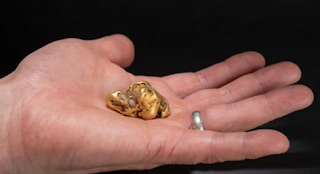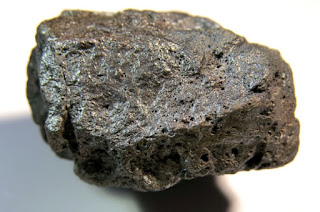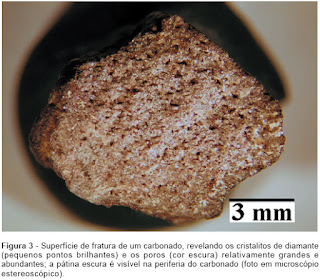Where to Find Gold in the UK
Let's take a look at where to find gold from the United Kingdom.
What many people do not realize is that you can find gold in the UK.
Finding gold can be extremely exciting, but you have to know where to look.
 |
| Gold Maps in United Kingdom |
Find Gold in United Kingdom
England has always been known as a rich country, but mineral wealth has never received much attention. The country is actually quite rich in mineral resources, and there have been discoveries of various minerals throughout the UK. Different areas produced different deposits of minerals. Iron, copper, silver, tin, and lead were mined in England, but with the high price of gold in recent years there has been a growing interest in the gold of occasional gold miners. In this article, we take a look at some of the best places to find gold in the UK.
Largest UK Gold Nugget Found in a River
The gold nugget was found in May 2019 and was named "The Reunion Nugget".
The "Reunion Nugget" with 121.3-gram, found in Scotland took the UK's largest nugget throne from a "Douglas Nugget", found in 2016 that weighs 85.7 grams.
The Largest Scottish Gold Nugget, “Douglas”.
 |
| Largest Scottish Gold Nugget |
The largest gold nugget found in Scotland was found in Perthshire in 2017, named “Douglas” as a tribute to the person who located the rare item, but only the first name was revealed. Due to its geological and cultural importance, it was considered important to preserve it.
The Scottish gold nugget “Douglas” has a weight of 85 grams.
Most of the Scottish gold was found as dust or flakes in river sands and gravels, eroded from much older stone.
Big chunks of gold are really scarce anywhere so this is an 85 gram nugget and even in Alaska and Australia in gold rush places 85 gram nuggets are quite rare so it's a really interesting thing to find.
In the 16th century, large amounts of gold dust and nuggets were found on the Scottish borders, especially at Glengaber Burn and Crawford Moor and many of these finds were turned into coins and Scottish royal regalia.
Most of the large "surviving" gold stones have been found in the 19th century, but none are as large as the Douglas.
Gold generally does not survive, large nuggets were found in the 16th century in Scotland, possibly up to a pound, but at that time they were all made into coins for Scottish regalia, Scottish honours, the royal insignia, or coins for issue on behalf of the state to show how rich the country was.
Therefore, none of these large nuggets have survived and this is by far the largest confirmed and known surviving Scottish nugget.
Largest gold nugget found in a Scottish river:
How to find gold in streams and rivers of UK
A growing number of people are heading to the streams and rivers in search of gold. There is plenty to be had, experts say, but probably not enough for you to quit your day job.
To find the specks of gold or even a nugget or two, you will need to the right equipment and keen sense of where to find it.
Where to find gold in the UK
Gold can and has been found in the UK for many many centuries. This can be verified due to the vast amount of gold to be found in the royal collections as well some recent treasure trove finds – a 12 year old boy with a metal detector found a 16th century pendant valued at 2.5 million British pounds- that detector paid for itself!!! Undoubtedly, gold will exist in many rivers, creeks and hard rock areas that have simply never been prospected before. If you live near a river system i would where to find gold in the ukrecommend getting a basic gold panning kit, learning the basics of gold panning and get familiar with where to find gold in a river so that you can test the gravels within the river system. It is best that you practice gold panning with some Pay-dirt at home before you venture out into your area.
Although some of the gold in the British museums would have been, ahem, acquired by the empire ;), the land itself does hold a lot of gold deposits, many of the artefacts within the British museums have been tested and have been found to have been crafted from locally found gold. As you can see from the image to the left, gold has been recovered in all parts of the UK – England, Scotland and Wales, below i will try to break them down into regional localities.
Gold Prospecting in UK
Gold panning UK locations:
England
Lake District, the Pennines, the Forest of Dean and Cornwall.
Scotland
Dumfries and Galloway (the origins of the Douglas Nugget as mentioned above).
Wales
The Welsh Gold Rush of the 1860s is long gone, but the Dolgellau Gold Belt in Snowdonia still yields gold to this day. The ancient Dolaucothi Gold Mines in Camarthenshire also offer visitors a chance to try panning with supervision, and the Parys Mountain in north-east Anglesey is currently being considered for a mining site.
Republic of Ireland
With a name like ‘Gold Mines River’ its unsurprising that this area in County Wicklow is a popular location for Irish gold hunters.
The locations above are known sites that still regularly produce gold, but the UK has miles of untapped countryside that has never even been prospected. Just because gold hasn’t been found there yet should not be taken to mean it doesn’t exist there. Prospectors are understandably secretive when they find a good spot, and many take prime panning locations to their graves.
Where to find gold in England
In England gold has been found in:
The Lake District – Mungrisdale, Dunmail Raise and Blencathra Mountain are reputed to be good spots and traces have also been found in Troutbeck and Sedbergh.
The Northern Pennines – a wealth of minerals, including gold has beed found here. Nenthead and the River Swale have both had reports of gold finds.
The Forest of Dean – In 1906 there were reports of gold being found near Wigpool in the Forest of Dean. Apparently there is still gold in the ground to be found.
Camborne; Falmouth, Cornwall – a gold mine has been opened in the area recently, no doubt the surrounding river will contains alluvial gold.
Parys Mountain – it is believed to contain more than six and a half million tonnes of copper, lead and zinc, with small amounts of silver and gold – not enough gold to make a mining operation viable, but definitely enough gold to make a prospectors time worthwhile.
Please note that these places have been found to produce large mounts of alluvial gold (river gold), other gold bearing localities are undoubtedly waiting to be discovered. It would also be very likely that many gold producing sites existed throughout history in England but have been forgotten over time, their exact locations may not have been passed on to future generations – this is a very common occurrence all over the world and usually happens when a prospector does not want to reveal his or her gold producing location, if you ever find a decent site, you’ll understand this secrecy :). Even when gold has not yet been found in a location it does not mean that the gold is not there, it most likely means that it has never been searched for. Get yourself a basic gold panning kit for 40£ or so,learn where to find gold in a river and take a day trip with family or friends and check out your local streams and riverbeds, it’ll be a fun day out no matter if you find gold or not.
Metal Detecting in England
Metal detecting is a more common practice in England than standard gold prospecting, this is due to the UKs rich history of invaders, plunderers and pilferers, all of whom would have had vast amounts of silver and gold in tow as it was the currency that was used at the time. It is easier to find many ounces of gold or silver coins with a metal detector than it is to prospect yourself, why go to the trouble of digging up rivers beds when some poor soul has done the work for you, probably thousands of years ago and with a whip at his back :).
These metal detecting finds are usually of Roman or Anglo-Saxon lineage and mainly consist of gold and silver coins, these will usually be purchased from the finder by UK museums and can sometimes simply be kept by the finder and sold to the highest bidder.
In 2013, an amateur metal detectorist found £100,000 worth of gold coins on his FIRST TRIP with a basic metal detector worth just 135£.
 |
| Amateur metal detector find gold coins in uk |
“Wesley Carrington was using the most basic metal detector when 20 minutes into his first foray he found 55 gold solidus dating back more than 1,600 years.
He had begun his search in woodlands near St Albans, Herts.
Mr Carrington said “I just thought I would give it a go. I would say after about 20 minutes it beeped. I found a coin that was gold-coloured, with a Roman figure on it.”
Days later he returned to the Berkhampstead shop where he had purchased his £135 metal detector and showed them his haul.
At an inquest in Hatfield, coroner Edward Thomas declared the find as a treasure trove and passed the matter to the British Museum to put an estimate on the items.
The value of the hoard, believed to be more than £100,000, will then be split between Mr. Carrington and the landowner.” Not bad for his first trip.
In January of 2015 Paul Coleman found 1 million pound sterling worth of silver coins on a metal detecting trip.
 |
| Coins found by treasure hunter Paul Coleman and wife Christine's |
“A hard-up metal detector fan told today how he found an amazing £1million hoard of coins.
Paul Coleman, 59, whose bank accounts are all in the red, almost stayed at home because he could not afford to fill up his car with petrol to go on the dig.
But hours later he ,unearthed more than 5,000 Anglo-Saxon silver coins – one of the biggest finds ever made in Britain.
Experts believe the hoard may have been buried after the Battle of Hastings to protect it from the Norman invaders.
Jobless Paul will split the money from his find with the landowner farmer.
He made the discovery just before Christmas and his present to wife Christine, 53, was a pledge to buy a new house.”
Due to the rich history of England and the UK in general, i would imagine that rich hoardes of silver and gold could be found in almost any location on the island. Silver and gold would have been buried by Lords all the way down to Peasants in an effort to preserve their wealth in the face of oncoming invaders, with the intention of digging their stash back up when the invaders have either left or passed through. Many of these hoarders would have been killed by the invaders or forced to move with them, hence the reason why the stash is stilll lying buried in the ground, waiting for the familiar beep beep beep of a metal detector.
Where to find gold in Wales
Gold in Wales has been found at Angelsea,Pembrokeshire, Dollacothi & Dollgelau , i know from personal experience that gold can be found in the gravels of the Mawddach river.
On a side note, a man recently found a gold nugget on a Welsh beach worth 50000£, this gold came from a ship that sank nearby in 1859.
Where to find gold in Scotland
Gold has been found in the following location in Scotland – Dumfries, Tyndrum, Glendevon, The Perthshire Hills and Helmsdale.
Watch the video:
Largest Gold Nugget in UK
The largest gold nugget found in the UK was discovered in one of Scotland's many rivers that heve gold.
"Reunion Nugget" 121.3 gram,
"Douglas Nugget", 85.7 grams.
ATTENTION:
You need permission to pan for gold on private or environmentally protected land; for more details see: britishgoldpanningassociation.co.uk
How to hunt for hidden heritage and natural treasures in Britain: codes of practice and the law.
You need permission from the landowner to metal detect on private land in the England, Wales and Scotland. It is illegal to metal detect on protected heritage sites. You can find out more about metal detecting codes of practice for archaeological artefacts and what to do if you discover ‘treasure’, HERE.
Gemstones found in UK:
September 7
The Gold International Day
"If you know of other places where you can find gold in England, add it to the comments just below."
The Gold International Day
"If you know of other places where you can find gold in England, add it to the comments just below."
Gold panning in the UK
Where to Find Native Gold in India
India Gold Rush
Source:






